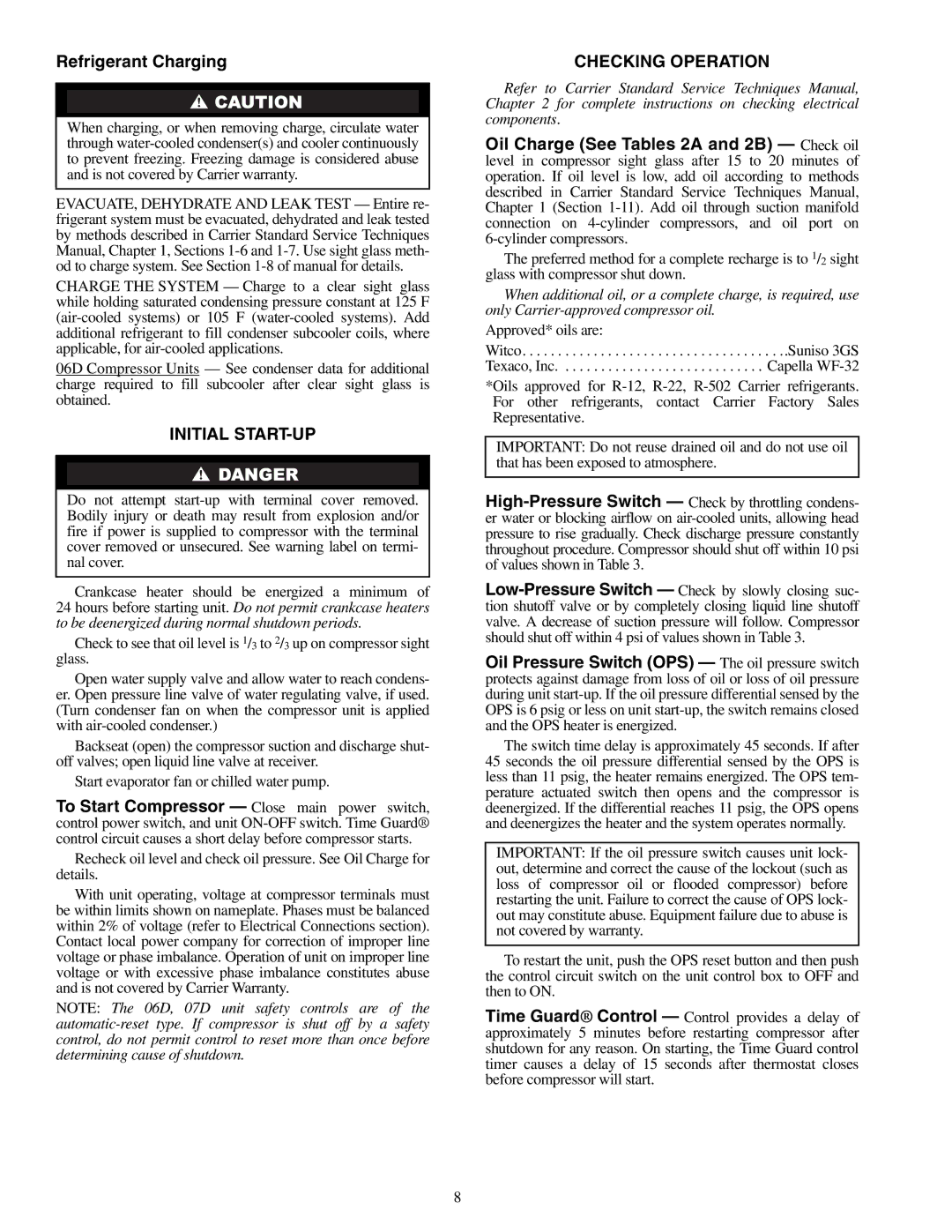
Refrigerant Charging
When charging, or when removing charge, circulate water through
EVACUATE, DEHYDRATE AND LEAK TEST — Entire re- frigerant system must be evacuated, dehydrated and leak tested by methods described in Carrier Standard Service Techniques Manual, Chapter 1, Sections
CHARGE THE SYSTEM — Charge to a clear sight glass while holding saturated condensing pressure constant at 125 F
06D Compressor Units — See condenser data for additional charge required to fill subcooler after clear sight glass is obtained.
INITIAL START-UP
Do not attempt
Crankcase heater should be energized a minimum of
24 hours before starting unit. Do not permit crankcase heaters to be deenergized during normal shutdown periods.
Check to see that oil level is 1/3 to 2/3 up on compressor sight glass.
Open water supply valve and allow water to reach condens- er. Open pressure line valve of water regulating valve, if used. (Turn condenser fan on when the compressor unit is applied with
Backseat (open) the compressor suction and discharge shut- off valves; open liquid line valve at receiver.
Start evaporator fan or chilled water pump.
To Start Compressor — Close main power switch, control power switch, and unit
Recheck oil level and check oil pressure. See Oil Charge for details.
With unit operating, voltage at compressor terminals must be within limits shown on nameplate. Phases must be balanced within 2% of voltage (refer to Electrical Connections section). Contact local power company for correction of improper line voltage or phase imbalance. Operation of unit on improper line voltage or with excessive phase imbalance constitutes abuse and is not covered by Carrier Warranty.
NOTE: The 06D, 07D unit safety controls are of the
CHECKING OPERATION
Refer to Carrier Standard Service Techniques Manual, Chapter 2 for complete instructions on checking electrical components.
Oil Charge (See Tables 2A and 2B) — Check oil level in compressor sight glass after 15 to 20 minutes of operation. If oil level is low, add oil according to methods described in Carrier Standard Service Techniques Manual, Chapter 1 (Section
The preferred method for a complete recharge is to 1/2 sight glass with compressor shut down.
When additional oil, or a complete charge, is required, use only
Approved* oils are:
Witco. . . . . . . . . . . . . . . . . . . . . . . . . . . . . . . . . . . . ..Suniso 3GS Texaco, Inc. . . . . . . . . . . . . . . . . . . . . . . . . . . . . Capella
*Oils approved for
IMPORTANT: Do not reuse drained oil and do not use oil that has been exposed to atmosphere.
Oil Pressure Switch (OPS) — The oil pressure switch protects against damage from loss of oil or loss of oil pressure during unit
The switch time delay is approximately 45 seconds. If after
45 seconds the oil pressure differential sensed by the OPS is less than 11 psig, the heater remains energized. The OPS tem- perature actuated switch then opens and the compressor is deenergized. If the differential reaches 11 psig, the OPS opens and deenergizes the heater and the system operates normally.
IMPORTANT: If the oil pressure switch causes unit lock- out, determine and correct the cause of the lockout (such as loss of compressor oil or flooded compressor) before restarting the unit. Failure to correct the cause of OPS lock- out may constitute abuse. Equipment failure due to abuse is not covered by warranty.
To restart the unit, push the OPS reset button and then push the control circuit switch on the unit control box to OFF and then to ON.
Time Guard® Control — Control provides a delay of approximately 5 minutes before restarting compressor after shutdown for any reason. On starting, the Time Guard control timer causes a delay of 15 seconds after thermostat closes before compressor will start.
8
